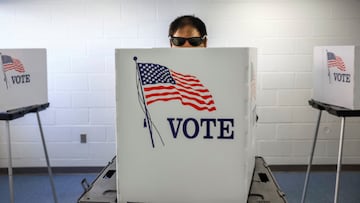The swing states where voter registration has favored Republicans since 2020
Across the board, more voters are not selecting a party affiliation when registering. But, of the two major parties, which have performed better in swing states?


As the November General Election rapidly approaches, the shifts in party affiliation in the swing states favor Republicans slightly. However, both parties have seen their numbers fall in many critical states.
Arizona, Florida, Nevada, North Carolina, Ohio, and Pennsylvania are the only swing states that make public voter registration numbers based on party affiliation. In Georgia, Michigan, and Wisconsin publish the totals but do not break down voter registration data by party. Georgia and Wisconsin have seen their voter list fall, while registration has increased in Michigan since 2020.
In the six states where party data is available, shows an advantage for the GOP as Democrats have seen their numbers fall in all. There is still time for these numbers to shift as some of this data is from the spring.
| State | Democrat (Change from 2020) | Republican (Change from 2020) | Independent (Change from 2020) |
|---|---|---|---|
| Arizona | -182,628 | -53,812 | 39,633 |
| Florida | -915,393 | 236,741 | -214,817 |
| Nevada | -86,109 | -17,646 | 232,978 |
| North Carolina | -155,890 | 126,521 | 509,927 |
| Ohio | -129,964 | 672,561 | 461,697 |
| Pennsylvania | -333,260 | -82,480 | -14,036 |
A look at the case in each state
In Arizona, both major parties have seen their voter registration fall, while the number of non-affiliated voters has risen by 40,000. The Republicans have lost fewer voters than the Democrats, and as of July 2024, Democrats make up 29.10 percent of the electorate while Republicans make up 35.41 percent. However, a recent poll sponsored by AARP found that while Trump is leading by one point, Democratic Senate candidate Congressman Ruben Gallego is leading by double digits.
Florida, which is by many no longer considered a swing state, has seen Republican voter registration increase by over 200,000. Now, members of the GOP make up nearly 40 percent of the electorate while Democrats make up only 31 percent. A New York Times/Siena College poll found the former president leading Vice President Harris by 13 points, though other polls show that Senator Rick Scott (R) is in a much tighter race with his lead falling within the margin of error of a poll by The Telegraph.
Moving west to Nevada where over 200,000 voters have registered without selecting a party-affiliation. Still, Democrats make up a slightly larger percent of the electorate:
| Democrat | Republican | Independent |
|---|---|---|
| 30.04% | 29.08% | 33.60% |
Recent polls published by FiveThirtyEight show that the presidential race is very close, though Senator Jacky Rosen (D) is leading her Republican challenger by more than 10 points.
North Carolina has seen increases in voter registration among Republicans and independents since 2020, with Democratic registration falling by -155,890. Democrats still make up a larger share of the electorate:
| Democrat | Republican | Independent |
|---|---|---|
| 31.39% | 29.83% | 37.80% |
In addition to the presidential race, voters in the state will elect a new governor in November. The race has been affected by recent storms that have left communities across the western portion of the state devastated. This horrific conditions and events have taken the focus off the Republican candidate, Mark Robinson, who was found to have made crude and racist comments on an online porn forum over a decade ago. Though his chances of winning have plummeted, Donald Trump still stands a chance, according to recent polls reported on by FiveThirtyEight.
Republicans in Ohio have shown why many Democrats are not investing in the state at the presidential level. With more than 600,000 GOP voters compared to 2020, Donald Trump stands a good chance of snagging the Buckeye State. However, that support for the former president should not leave the party convinced that they will be able to unseat the Democratic Senate incumbent Sherrod Brown (D). The divided results might not come as a surprise when considering 71.15 percent of voters are not affiliated with either party.
Related stories
Moving over to Pennsylvania, Democrats have an advantage when it comes to the makeup of the electorate:
| Democrat | Republican | Independent |
|---|---|---|
| 44.98% | 39.96% | 15.07% |
The state is considered a must win for the vice president and the polls are split. A Quinnipiac University which spoke with voters between October 3 and 7, found Harris had a 2 point advantage, while a InsiderAdvantage poll conducted between October 7 and 8 found that Donad Trump was in the lead by 2 points.
Complete your personal details to comment